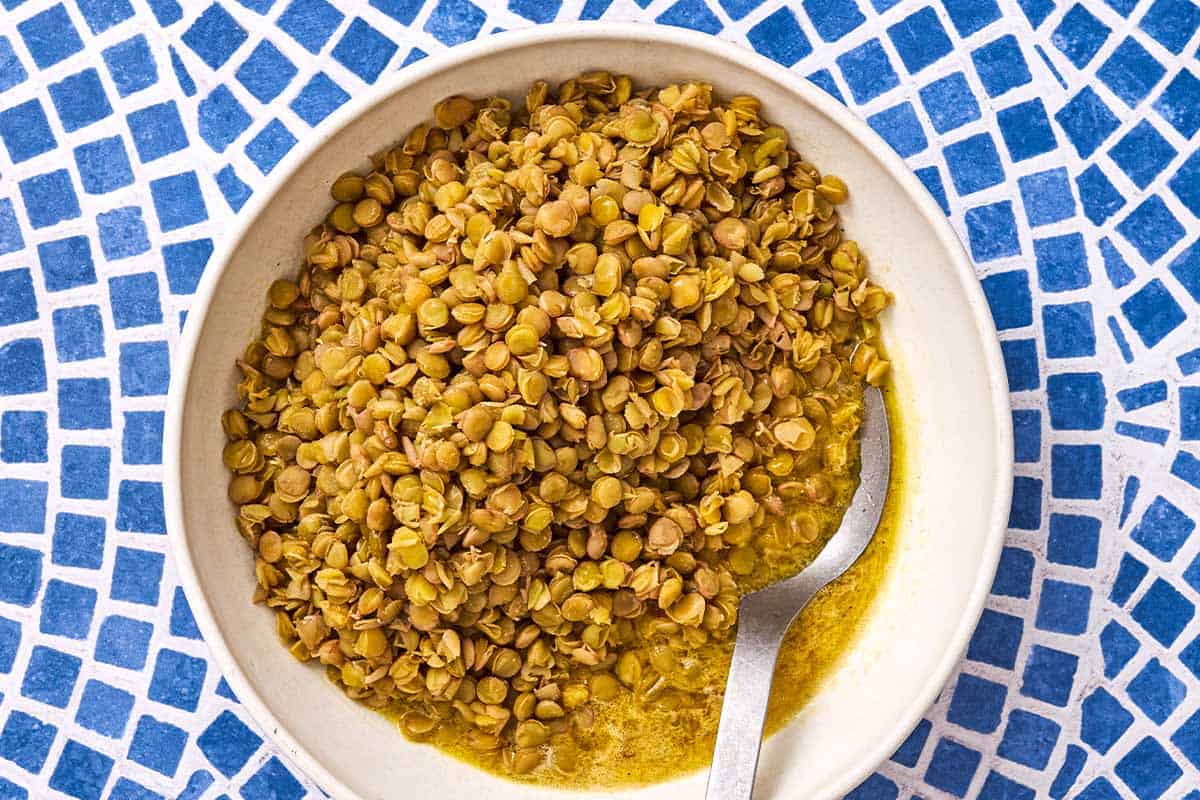This vegan French lentil salad recipe is the whole package: full of plant-based protein, fresh veggies, delicious flavor, texture, and it’s even better the next day!

People often ask me how to incorporate more heart-healthy, plant-based protein into their diet. I have one word for them: Legumes! And if I had to pick just one favorite legume, it would be lentils. I use them in soups, add them to rice dishes like Mujadara, and make the most of vegetables in my fridge like in this French lentil salad recipe.
Lentils are so easy to work with because you don’t have to soak them overnight. Plus they absorb all of the delicious Mediterranean flavors I like to pile onto my salads. In this recipe, I dress the lentils in a garlic lemon dressing, with Urfa Biber, a Turkish dried pepper that adds a mild kick and slightly smoky undertone (though you can substitute with chili flakes if you’d like).
Then for color, freshness, and crunch I toss in cucumber, bell pepper, and green onions, along with parsley and mint, making this lentil salad both aromatic and refreshing.
Table of Contents

Ingredients for this Lentil Salad Recipe
Most of the ingredients for this recipe are likely already living in your fridge, and the ones that aren’t are worth seeking out. You’ll need:
For the Dressing
- Lemon juice: Lifts the richness of the lentils, adding a good tang.
- Fresh garlic adds a savory, spicy kick.
- Kosher salt and black pepper enhance the flavor of the dressing.
- Urfa Biber is optional, but it adds a complex kick: mildly spicy with a tannic, slightly smoky quality.
- READ MORE: Urfa Biber: The Turkish Chili Pepper You Want In Your Spice Drawer.
- BEST SUBSTITUTE: Aleppo pepper or red chili flakes (will be spicier).
- TRY IT: Order Urfa Biber from our spice shop.
For the Lentil Salad
- Lentils: I use French green lentils as they keep their shape well when added to salads. You can also use Puy Lentils, which are a little more expensive and grown in a specific region in France, or black lentils which also hold their shape well. I don’t recommend using red lentils, they break down too much and are best used in soups.
- Bay leaf adds an aromatic quality to the lentils as they cook. You can use fresh or dried.
- English cucumber: Adds a refreshing note. English or Persian cucumbers are best since they have tender skin, but you can always peel a standard slicing cucumber.
- Bell pepper: I like a mix of yellow or orange and red for a good pop of color and sweet, fresh flavor.
- Green onions add a mild onion-ey flavor without overpowering the salad. Another mild allium works in their place, like shallots or chives.
- Fresh herbs bring this salad to the next level. I used parsley and mint (and I wouldn’t substitute with dried) but cilantro, dill, or basil could work in their place.

Ingredient Spotlight
Whether you’re making brown, green, red, or black lentils, they are an amazing source of vegan protein that’s rich in fiber, iron, folate, and zinc–see the USDA for lentils’ full nutritional breakdown.
They also absorb dressings, sauces, broth, and flavor makers like little mini sponges, making them so comforting and delicious. However, not all lentils should be used in all recipes. The best lentils for salads are black or French green or Puy lentils, which maintain their shape even when fully cooked. I save red lentils for creamy soups, and brown lentils float among all dishes depending upon how long you cook them.
- French Green Lentils: These are my first choice when it comes to salads or any recipe where I want to make sure the lentils hold their shape, and add some texture to the recipe. I use them in this French Lentil Salad recipe, but also in recipes like this roasted eggplant stuffed with lentils.
- Puy lentils are a type of green lentil with geographic protection. They come from the Le Puy region in France. They tend to cost more, but they hold their shape and are also a great option for salads.
- Black lentils are also an excellent choice for salads but will work well in soups where you want them to keep their shape. If you want them to break down a bit for soup, cook them for an additional 10 minutes beyond the package instructions. If you want to keep their shape cook them until al dente—tender but firm.
- Brown lentils are your standard lentil and probably the one familiar to most people. They work in salads and soups or in recipes like Adas Polo, a Persian rice and lentil recipe with dates and raisins. They will break down a little bit contributing to the creamy texture of sturdier lentil soups and stews.
- Red lentils: These legumes are more orange than red, but they break down into a creamy consistency when cooked which makes them a great option for creamy soups like Easy Greek Red Lentil Soup or Turkish Red Lentil Soup. They are not a great choice for salads.

How to Make French Lentil Salad Recipe
My favorite thing about this lentil salad recipe is that the flavors just get louder as they get to know each other. The lentils soak up all the dressing and the herbs start to make their mark on everything they touch. You may want to make a big batch for leftovers all week! Here are the steps:
- Make the dressing. First, juice 2 large lemons into a large bowl. Press or mince 1-2 garlic cloves and add to the bowl, along with a big pinch of salt and pepper and 1/2-1 teaspoon of Urfa Biber (if using). Continue whisking as you drizzle in 1/3 cup olive oil. Whisk until emulsified. When finished, taste and adjust the seasoning to your liking. Set aside as you cook the lentils.
- Cook the lentils: Rinse 1 cup of black or green lentils and add to a medium pan set over medium-high heat. Add 1 bay leaf and 3 cups of water (or enough water to cover the lentils by at least 1 inch). Bring to a boil, then lower the heat and cover. Simmer for 20 to 25 minutes, or until the lentils are tender but still have a nice bite to them. Once they’ve finished cooking, drain through a fine mesh strainer.
- While the lentils cook, prep your veggies. Core and chop 2 bell peppers (I like a mix of yellow or orange and red). Trim and chop 2 green onions. Chop enough parsley and mint leaves to yield 1/2 cup of each.
- Combine the dressing and the lentils: Add the warm drained lentils to the bowl with the dressing and toss to coat. Set aside to cool for a few minutes.
- Add the vegetables: Once the lentils have cooled a bit (they can be warm just not hot), add the cucumber, bell pepper, roasted red pepper, green onions, parsley, and mint. Toss gently to combine.
- Taste and adjust seasoning. Serve immediately, or cover and refrigerate for up to 3 days.
Ways to Mix it Up
This can be a “fridge salad” situation—feel free to throw in whatever you have lying around. Some ideas:
- Add roasted red pepper: Swap the fresh red bell pepper for a roasted red pepper to add another layer of flavor and texture. You can roast your own bell peppers or use one from a jar.
- Add even more protein: Throw in a drained can of chickpeas for a vegan option. Or top with grilled chicken breast or a hard-boiled egg.
- Add a fresh peppery note: Add arugula or thinly sliced radish.
- Add tangy-creaminess: Top with crumbled feta cheese.

What to Serve with French Lentil Salad
You could eat lentil salad for breakfast, lunch, or dinner. But my absolute favorite way to enjoy this recipe is as part of a power lunch spread, with flatbread, 10-Minute Whipped Labneh Dip, and Dolmas from my local market, (or rolled from scratch if I find extra time on Sunday afternoon).
More Lentil Salad Recipes
Browse All Mediterranean Recipes
Visit Our Shop

Stock Up and Save!
Save when you bundle our favorite organic black, green, and red lentils.
French Lentil Salad with Cucumber, Bell Pepper, and Fresh Herbs

Ingredients
For the Dressing
- 2 large lemons, juiced
- 1 to 2 large garlic cloves, pressed or minced
- Kosher salt
- Black pepper
- 1/2 to 1 teaspoon Urfa Biber (optional), or substitute Aleppo pepper/red chili flakes
- 1/3 cup extra virgin olive oil
For the Lentil Salad
- 1 cup black or green lentils, rinsed
- 1 bay leaf
- 1 English cucumber, cut into large pieces
- 1 red bell pepper (fresh or roasted), cored and chopped
- 1 orange bell pepper, cored and chopped
- 2 green onions, trimmed and chopped
- 1/2 cup chopped fresh parsley leaves
- 1/2 cup chopped fresh mint leaves
Instructions
- Make the dressing. In a large bowl, whisk together the lemon juice, garlic, a big pinch of salt and pepper, and the Urfa Biber (if using). Continue whisking as you drizzle in the olive oil. Continue to whisk until emulsified. Taste and adjust the seasoning to your liking. Set aside as you cook the lentils.
- Cook the lentils. In a medium pan set over medium-high heat, add the lentils, bay leaf, and 3 cups of water (or enough water to cover the lentils by at least 1 inch). Bring to a boil, then lower the heat and cover. Simmer for 20 to 25 minutes, or until the lentils are tender but still have a nice bite to them. Drain through a fine mesh strainer.
- Combine the dressing and the lentils: Add the warm lentils to the bowl with the dressing and toss to coat. Set aside to cool for a few minutes.
- Add the vegetables: Once the lentils have cooled a bit (they can be warm just not hot), add the cucumber, bell pepper, roasted red pepper, green onions, parsley, and mint. Toss gently to combine.
- Taste and adjust seasoning. Serve immediately, or cover and refrigerate for up to 3 days.
Video
Notes
- Shop this recipe: Visit our shop to browse quality Mediterranean ingredients including the olive oil, Urfa biber, and lentils used in this recipe.
- Use whatever seasonal veggies you have on hand.











Love this so much. Great for packing lunches, by itself or in a wrap. Versatile. The dressing is absolutely delicious.
Thanks so much, Tanna!
My husband and I had this for dinner last night and loved it. I used Aleppo pepper that I had purchased from you, French green lentils and followed the recipe as written. I love that leftovers would last for a couple of days and my husband took some to work for lunch today. Last night we had it as a main dish. Thank you for sharing.
So glad it was a hit for you and your husband, Vicky! Thanks for the great review!
I only used one lemon and I still found it to much I did as someone else on your comments did I added honey and a little bit of Dijon this is the second recipe I’ve tried that has been had too much lemon
I made this last night as a main dish. It was awesome……so delicious. I accidentally bought cilantro as opposed to parsley but it was so good anyway! I will definitely be making this one again this summer
So glad you enjoyed it!
I made this last week and it’s fabulous. My husband, who is not big on veg, dishes ate two bowls and so did my daughter. I thought I would have some left over for lunches, but that didn’t work out.
I made this last night thinking I would have few meals for the week. However, my husband, who isn’t big on veg. dishes), had two bowls and so did my daughter. It was very tastey. I served with you pita bread. Oh, well, back to the kitchen to cook some more.
This recipe is amazing! I did switch the green pepper for the orange pepper. It is light and crisp and embodies the Mediterranean flavor!
Hi, Amy! Summer, from The Mediterranean Dish, so glad you love the salad! Thanks for taking the time to let us know!
Love the recipe!
I was wondering if the nutritional information is based on per serving or for the entire dish?
Thank you!
Hi, Mary. The nutritional info here is per serving.
I had some lentils and was just looking for a simple cold salad recipe. I’m also on a low sodium diet so I usually have to modify things a bit. The lentils were simply delicious. No salt modification needed. I didn’t have the green onions so I went with a bit of white onions. Sadly, no fresh mint on hand and went with dried. I can’t wait to make it again with all the “right” ingredients. The leftovers are even better the next day. I didn’t use all the dressing and saved the rest for my tuna salad. Bravo! Thank you.
Thanks so much, Tina!
I love all the ingredients in this salad but I feel like the lemon juice to EVOO ratio might be a little off. Juice of 2 lemons to 1/3 c. EVOO give it quite an edge. I toned it down with a small bit of honey and dijon emulsified in added in. That worked.
Love the herbs…and this has me scheming about other ways to incorporate lentils into salads. They’re really good!
I’m just starting the Mediterranean diet and this salad is delicious! Easy to make and satisfying.
So glad you enjoyed it, Brenda!
I made this recipe as written, except with French lentils and Aleppo pepper. I did not care for the flavors. It was missing something, but I could not put my finger on it. I would not make this again, but will try the Mediterranean Dish lentil salad recipe with pomegranate arils.
Im giving 5 stars this recipe is very nutritious.
Loved the lentil salad. I used brown lentils and it tasted great!! Will definately make this again soon as I enjoy all the salad recipes and make them often for my dinner.
Thanks!
Thanks so much, Joyce.
Made this salad today. Used Aleppo pepper and it is simply delicious. I did just order the Urfa biber and will happily make it again. Really a great dressing!
Thanks, Andy! So glad you enjoyed it!
Under the nutrition heading at the bottom of each recipe, are the data per recipe or per serving?
And when the recipe could be 6 or servings by choice, does the data divide by 6 or 4.
I love your recipes.
Hi, Chris! The nutrition here is per serving, based 6 servings. Enjoy!
I am always looking for a quick and fresh option for lunch and I will be looking forward to this. Tasting this fresh and I can imagine how well this salad will meld in the next day or so. I can see myself eating this with some shrimp or an egg. I could definitely see how this would be fantastic with a little feta and a big handful of arugula stirred in before serving. Thank you for sharing this recipe!
I love all your ideas for add-ins! Thanks so much for sharing!